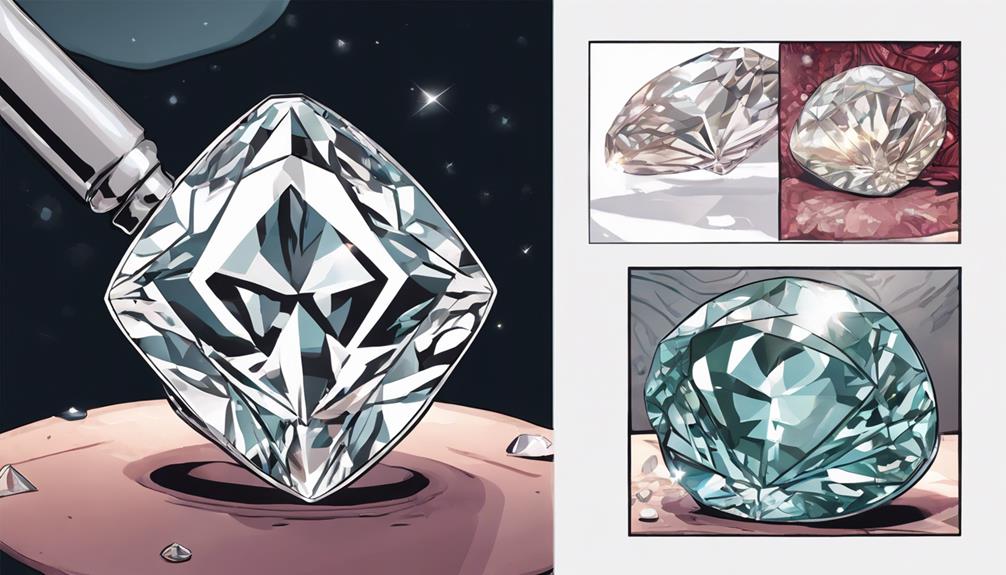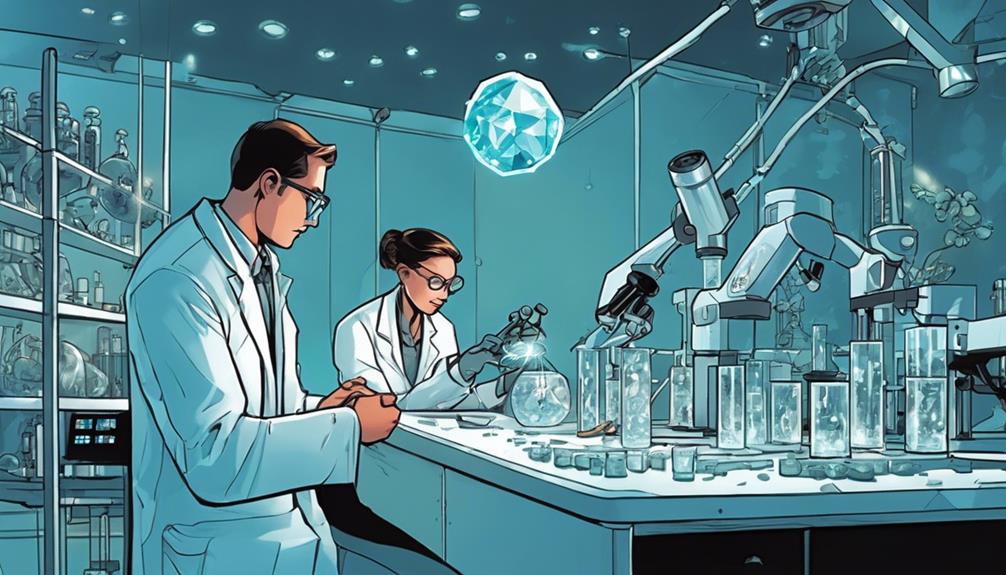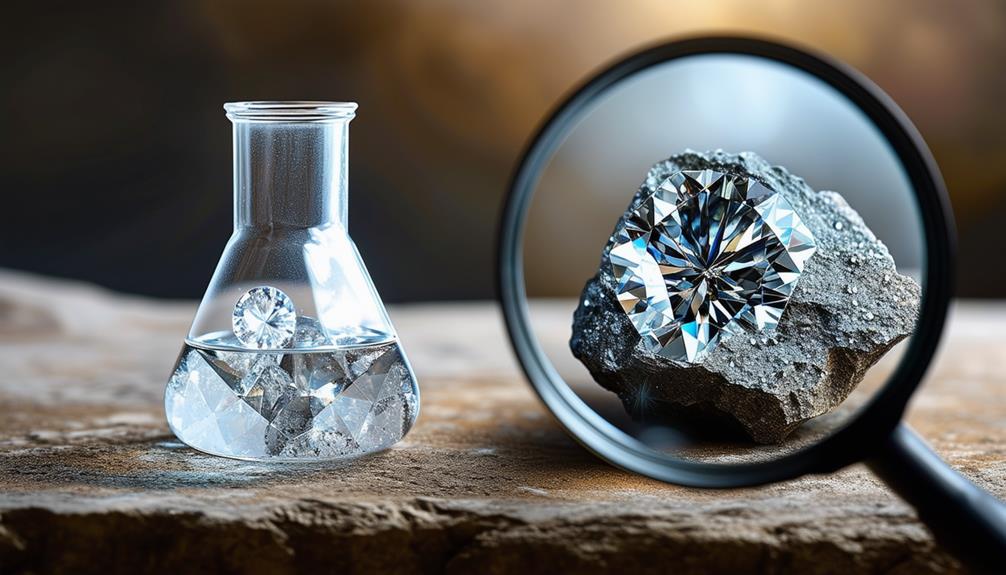Article Contents
Lab-grown diamonds are produced in controlled settings using methods such as High Pressure High Temperature (HPHT) and Chemical Vapor Deposition (CVD). These processes result in diamonds with fewer inclusions compared to natural diamonds, often leading to superior brilliance and colour.
While natural diamonds contain unique inclusions that may appeal to those who value natural characteristics, lab-grown diamonds are celebrated for their purity and consistency. Both types of diamonds maintain considerable value in the market.
However, lab-grown diamonds are often more affordable and considered more sustainable, aligning with ethical production practices in the jewellery industry. This distinction is crucial for understanding consumer choices and the evolving dynamics of the diamond market.
Key points
- Lab-grown diamonds generally have higher purity levels due to the controlled conditions in which they are manufactured.
- In contrast, natural diamonds often feature unique inclusions that, while lending authenticity, may compromise purity.
- The use of precise technologies such as High Pressure High Temperature (HPHT) and Chemical Vapor Deposition (CVD) in the production of lab-grown diamonds enables meticulous impurity management.
- Techniques like spectroscopy and microscopic analysis are essential for discerning the purity distinctions between lab-grown and natural diamonds.
- The preference for ethical sourcing and environmental considerations enhances the appeal of the higher purity found in lab-grown diamonds.
Defining Diamond Purity
Diamond purity refers to how free a diamond's crystal structure is from impurities such as nitrogen and boron. This aspect is crucial as it significantly influences a diamond's brilliance, colour, and overall market value. The diamond industry utilises specific standards to assess the purity of both natural and lab-grown diamonds accurately.
Natural diamonds are created over billions of years beneath the Earth's surface and often contain impurities that can alter their clarity and colour. These natural inclusions give each diamond unique characteristics but also impact their overall purity. In contrast, lab-grown diamonds generally achieve greater purity due to the controlled conditions of their synthesis, which limits the presence of unwanted elements and enhances the diamond's properties.
Adherence to established industry standards for purity assessment is vital. These standards provide a consistent method for evaluating diamonds, ensuring transparency and enabling consumers to make informed decisions based on the quality and authenticity of the diamond. This practice is essential for maintaining the integrity and trust within the diamond industry.
Lab-Grown Diamond Creation
Lab-grown diamonds are created using two primary methods: High Pressure High Temperature (HPHT) and Chemical Vapor Deposition (CVD). The HPHT approach mimics the natural diamond-forming environment by applying extreme pressure and temperature to carbon, transforming it into diamond. The CVD technique involves introducing carbon-rich gases into a vacuum chamber, where carbon atoms gradually accumulate on a diamond seed, forming the diamond layer by layer. Both techniques enable precise control over the diamond's characteristics, ensuring high standards of clarity and colour.
In addition, lab-grown diamonds promote environmental sustainability and ethical production practices. Unlike traditional diamond mining, which can cause significant ecological and social disruption, manufacturing diamonds in laboratories minimises environmental impact and avoids the ethical issues associated with mining. This supports the growing consumer demand for products that are both luxurious and ethically sourced.
As the cost of producing lab-grown diamonds continues to fall, these gems become a more affordable alternative to natural diamonds, making high-quality jewellery more accessible and supporting a shift towards more sustainable and ethical practices in the jewellery industry. This advancement in diamond technology represents a significant move towards a more responsible and inclusive approach in gemology.
Natural Diamond Formation
Natural diamonds are formed deep within the Earth's mantle, where extreme heat and pressure over billions of years transform carbon into these precious stones. This process, occurring at depths of about 150-200 kilometres below the Earth's surface, showcases the dynamic nature of our planet. The diamonds are then brought closer to the surface by volcanic eruptions, travelling through magma conduits primarily composed of kimberlite and lamproite. These eruptions not only expose diamonds but also highlight their rarity and the significant natural forces involved in their creation.
Approximately 60% of the world's natural diamonds are mined in Africa, with other significant contributions from countries like Australia, Russia, Canada, and India. These diamonds are typically extracted from the ancient volcanic pipes or recovered from alluvial deposits in rivers and seabeds. Each diamond bears a unique record of its volatile formation.
The formation of natural diamonds, a process rich in historical and natural significance, exemplifies nature's capability to create valued and sought-after treasures, reflecting a balance of scientific understanding and appreciation for natural beauty.
Purity Testing Methods
In assessing the purity of diamonds, both Spectroscopy Analysis Techniques and Microscopic Examination play crucial roles. These scientific methods are indispensable for accurately distinguishing between lab-grown and natural diamonds by identifying their distinct characteristics.
Spectroscopy Analysis Techniques
Spectroscopy techniques, such as Raman, FTIR, and UV-Vis-NIR spectroscopy, play a crucial role in assessing the purity of both lab-grown and natural diamonds. These methods are capable of analysing impurities, trace elements, and chemical compositions, providing vital data about each diamond.
While these techniques are powerful, they sometimes struggle to distinguish extremely subtle differences, which can impact the accuracy of purity assessments. Therefore, additional tests are often necessary to confirm results.
The precise evaluation of diamond purity is crucial as it significantly affects their market value and consumer confidence. By effectively utilising these spectroscopy methods, one can ensure the authenticity and quality of diamonds, thus preserving their value and appeal.
Microscopic Examination Insights
Microscopic examination is crucial for distinguishing between lab-grown and natural diamonds by analysing their crystal structures and inclusion patterns. Lab-grown diamonds typically have uniform crystal structures and minimal inclusions due to their controlled synthesis processes. These diamonds are engineered to achieve high clarity, free from the natural trace elements found in mined diamonds.
In contrast, natural diamonds exhibit varied crystalline forms and contain unique inclusions and a spectrum of trace elements that reflect their geological origins. Such microscopic analysis is vital for identifying the growth patterns that help verify a diamond's authenticity and quality, essential for making an informed decision between choosing a lab-grown or a natural diamond.
Effect of Purity on Value

When assessing how purity impacts the value of diamonds, it is important to take into account the unique chemical compositions and clarity grades of both lab-grown and natural diamonds. These factors have a significant influence on the sparkle and worth of the stones.
A thorough comprehension of these distinctions not only provides consumers with the information needed to make informed choices but also underscores the intricate connection between natural elements, technological progress, and aesthetic aspects in the study of gemstones.
Assessing Chemical Composition
The market value of diamonds, whether lab-grown or mined, is heavily influenced by their purity. Key considerations include:
- Chemical Composition and Purity: Both lab-grown and natural diamonds share the same chemical composition, adhering to the industry's strict purity standards.
- Market Impact: The consistent purity of lab-grown diamonds presents a sustainable and economical alternative, affecting market trends and consumer preferences.
- Consumer Education: Informing consumers about the chemical composition and purity of diamonds aids in making educated choices, allowing them to select between lab-grown and natural diamonds based on factual information rather than misconceptions.
These elements highlight the crucial role of purity in determining the desirability and value of diamonds in the current market.
Differences in Clarity Grading
Clarity grading is a crucial aspect in evaluating the purity of both lab-grown and natural diamonds, significantly impacting their value. Natural diamonds typically feature inclusions that arise from their geological formation, influencing their clarity and market value.
In contrast, lab-grown diamonds, created in controlled environments, generally exhibit fewer imperfections, often resulting in higher clarity grades. These differences in clarity not only affect the appearance and pricing of the diamonds but also reflect evolving industry standards and consumer preferences.
As technology advances, the production of flawless lab-grown diamonds becomes more feasible, appealing to consumers who prioritise perfection. Meanwhile, others may value the unique natural inclusions in diamonds as signatures of their authenticity and natural origin, which adds both aesthetic and sentimental value to the jewellery.
Purity in Market Perception
Market perception of lab-grown diamonds is often characterised by their exceptional purity and ethical origins, which appeals to consumers who value both aesthetic and ethical considerations in their purchases. This shift towards ethical sourcing reflects broader market trends. The uniform quality and sustainable production of these diamonds further bolster their image as symbols of both luxury and responsibility.
The market perception of lab-grown diamonds is shaped by three primary factors:
- Ethical Sourcing: With increasing consumer awareness about product origins, lab-grown diamonds present a responsible option. They circumvent the ethical conflicts associated with the extraction of natural diamonds, offering consumers luxury without guilt.
- Environmental Sustainability: Lab-grown diamonds are produced with significantly reduced impacts on natural resources, making them attractive to environmentally conscious buyers.
- Transparency and Purity: Lab-grown diamonds are noted for their exceptional clarity and minimal impurities. The transparency of these diamonds extends beyond their physical properties to include the openness and traceability of their manufacturing process.
These aspects make lab-grown diamonds a compelling choice for consumers seeking to make ethically and environmentally sound luxury purchases.
Future of Diamond Purity

Advancements in lab-grown diamond technology are redefining industry standards for purity. These synthetic diamonds not only offer superior purity but also promote ethical sourcing and sustainable production practices. By employing rigorous quality control, lab-grown diamonds now consistently achieve a purity level that surpasses that of natural diamonds. This technological and ethical shift empowers consumers to select diamonds that reflect their values.
The drive for higher purity is aligned with increasing consumer demand for transparency and ethical responsibility in the diamond industry. Innovations continue to improve the production processes of lab-grown diamonds, minimising their environmental impact and enhancing their appeal to eco-conscious consumers. As a result, the demand for these ethically sourced and exceptionally pure diamonds is on the rise, positioning lab-grown diamonds as symbols of modern luxury and ethical integrity in the market. This shift indicates a significant move towards lab-grown diamonds as preferred choices for both their ethical and environmental benefits.
Frequently Asked Questions
Are lab-grown diamonds purer than natural diamonds?
Lab-grown diamonds often have fewer impurities than natural diamonds because their production in controlled environments allows for precise management of the chemical processes involved. This results in a high level of purity and consistent quality across different lab-grown diamonds.
Can an expert distinguish between lab-grown and natural diamonds?
Experts can distinguish between lab-grown and natural diamonds using specific identification techniques such as spectroscopy and microscopic analysis. Moreover, certifications from respected institutions like the Gemological Institute of America (GIA) help confirm the origin of the diamonds, ensuring precise identification of their characteristics.
Do Lab-Grown Diamonds Have Better Clarity?
Lab-grown diamonds often have superior clarity compared to natural diamonds because they are created in controlled environments that significantly reduce the presence of inclusions and other flaws. This makes them an appealing option for those looking for gems with fewer imperfections.
What percentage of diamonds are lab-grown compared to natural?
Roughly 2-3% of diamonds in the market are lab-grown. This trend shows a move towards more sustainable and ethically aware consumer choices, as well as lower production costs. However, the majority of diamonds sold are still naturally sourced.
Summary
In summary, the advancement of diamond purity highlights human creativity and our ongoing pursuit of excellence.
As technology progresses and consumer attitudes shift, the line between lab-grown and natural diamonds is likely to diminish.
Regardless of origin, the true worth and allure of a diamond are embodied in its purity, symbolising enduring clarity and brilliance.

